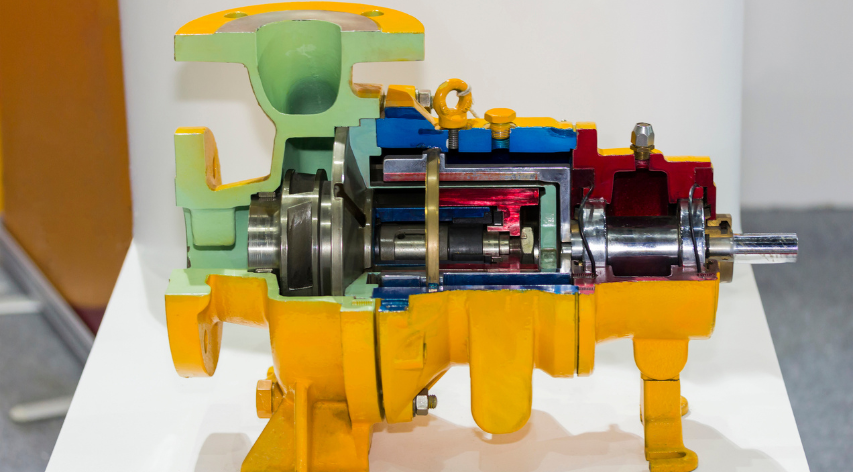Reducing Coupling Weights in Large Motor-Driven Pumps


One of the major issues in designing large motor driven pump applications is minimizing the overhung weight on the pump rotor. Motor or gearbox drives are designed and sized independently of the driven unit. They are based on motor frame size and/or gearbox frame sizes and the drive component manufacturer has no information on the actual driven unit.
In motors, the design of engineered motors is based on years of experience and rules of thumb. The motor rotor is significantly heavier than the pump rotor, thus requiring it to be much larger in diameter than the driven unit size to support the rotor weight and give an acceptable bearing surface area. It is not unusual for the motor output shaft size to be twice the input shaft size of the driven unit shaft.
Size Matters
The shaft size differences are basically a product of economics. It cost money for a motor manufacturer to machine a shaft, so the less machining they have to do, the better, for them that is. Again, the motor output shaft design is not dependent on the torque requirements of the driven unit, it is dependent on the mechanical design of the motor rotor to support the rotor weight and provide adequate bearing surface area. So, to minimize cost, the finished output shaft size is the same as, or very close to, the size of the shaft in the bearing area. This reduces machining time and therefore cuts cost. They simply design a motor, make a drawing, and send it to the driven equipment vendor and say this is it.
For decades, the Driven Equipment vendors took the drawing and did their best to work with the shaft parameters without question. They sized the coupling based on the available design information. In my experience in sizing couplings over the years, the speed, torque requirements, and power requirements of the coupling were all calculated, but the deciding factor of the coupling size 90% of the time was the maximum allowable bore diameter of the coupling hub. Every coupling hub has a maximum allowable bore diameter that is independent of the power needs of the coupling. In order to transmit the torque, there is a limit on the remaining radial thickness of the coupling hub after boring it to fit the shaft. If it is a key driven application, which most pump applications are, the maximum allowable bore is even smaller.
So, what happens?
You go through all the sizing criteria of the coupling and end up with the coupling size being determined by the output shaft size of the driver. The result is a coupling sometimes 2-3 times the size required to transmit the power, which is what a coupling is actually designed to do. The result is a large coupling hub on the driven unit with a very small bore, excessive overhung weight on the pump rotor, which for a large multistage pump is very undesirable from a Rotordynamics perspective.
On a past project where there were a large number of high horsepower motors (3350 hp) driving large multi-stage pumps. In reviewing the drawings, the couplings specified were several times larger than required for the power of the pumps. They were spacer couplings and the center sections of the disc pack spacer couplings weighed several hundred pounds. The overall coupling weight was in excess of 600 Lbs. Not only was this an issue with Rotordynamics, it was a maintenance issue as well. These couplings had to be removed in order to change the mechanical seal on the inboard end of the pumps.
In reviewing the coupling application, as expected, the determining factor was the motor output shaft size. The motor output shaft was 6 inches, while the pump input shaft was 3-3/4 inches. The motor manufacturer was visited to discuss the motor shaft size. During those discussions, the manufacturer revealed that the safety factor used in designing the shaft output was 10-1. This turned out to be a common thread among a number of motor manufacturers. When asked why this was the practice, the answer was the expected “we’ve always done it that way.” This methodology is somewhat understandable in that motor have been around for a long time. When motors were first manufactured, the quality and consistency of the steel used for the shafting was likely suspect. That is not the case today.
Solution
An obvious solution to the issue of the coupling was to reduce the motor output shaft size to match the pump input shaft size. When approached with this concept, there was some reluctance by the motor manufacturer – stating that this was their standard and they were reluctant to deviate from it. The manufacturer was asked to do a Finite Element Analysis (FEA) of the motor to pump shaft juncture to determine the feasibility of reducing the output shat size. The result of the study showed that when the motor shaft size was reduced, there was still a 4.38 safety factor for the shaft. After some consternation, they agreed to engineer the motor output shafts to match the pump input shaft size.
This resulted in a significant reduction in the coupling size and, therefore the weight. While the reduction in the weight of the coupling center section significantly helped the Rotordynamics issue for the pump rotor, the weight was still such that it would require a crane to lift the center section.
In searching for a solution, the concept of a double diaphragm was explored. As it turned out, while the diaphragm couplings were somewhat more expensive, the center section weight was reduced to the point that a worker could easily handle the coupling center section and hub so that a crane was not required for maintenance. The total reduction in coupling weight from the original proposed application was 680 lbs. This was a big help to the Rotordynamics and prove to be some of the smoothest pump-motor operations ever observed for pumps of this size. The overall vibration levels were less than 0.1 mils, which is extraordinary for pumps of this size.
While this condition is prevalent in most all motor sizes, it is not cost effective to pursue it for NEMA frame motors, but it should be considered for all engineered motor applications. It may also apply to steam turbine and gear driven pumps.
Have a question or need more information? You may post a comment on this blog for the author below. If you have a question about Becht Services you may click the link below.






